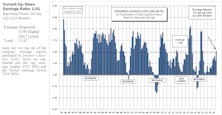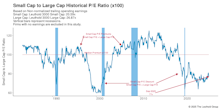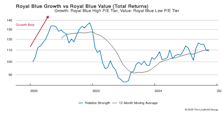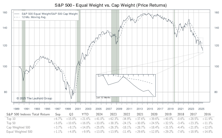Stock Market Internals Earnings Momentum, Small/Mid/Large Caps, Growth/Value/Cyclicals, and Additional Factors
Gaining Steam
The latest Up/Down ratio is 1.64—the second consecutive above-average reading for this vignette. Since the GFC, outperforming quarters have most commonly appeared in chunks of four or five. Still, for now, the story of EPS-growth expansion continues to gain steam.
Valuations: Small Cap Vs. Large Cap
It’s been five long years since Small Caps had their last sustained relative-strength rally: From November 2020 through March 2021, the S&P 600 gained an astounding 51% versus the S&P 500’s +22%.
Leadership Dynamics: Growth/Value/Cyclical
Last month, Royal Blue Value (+3.5%) outdid RB Growth (-4.1%) for the first time since April 2022. Over the last two years, Royal Blue Growth is up 52%, just a bit more than Royal Blue Value’s gain of 51%.
Other Market Undercurrents
Five of the Magnificent Seven firms ended November in the red. Despite that turbulence at the top, the S&P 500 still managed to eke out a gain for the seventh-consecutive month. The valiant November effort from the index’s 2025 underdogs—Value, High Dividend, Low Volatility, and Equal Weight—won’t change much in the final assessment of the year.
Earnings Momentum Holds Firm
The Up/Down ratio reads 2.14. We have to go all the way back to October 2021 to find a higher “one-month” ratio. Aside from the Q1-25 hiccup, the ratio has advanced the past seven quarters and now sits at a level generally associated with a robust economy.
Other Market Undercurrents
An 8.5% gain, modest by Nvidia standards, propelled that firm to a congruent 8.5% weight in the S&P 500—a new record. The semiconductor firm also achieved the stock market’s first $5 trillion valuation last month. That’s a little larger than the annual economic output of Germany—or the combined output of Central and South America.
Up/Down Earnings Above Average!
The Up/Down ratio reads 1.51. This is the first time the “three-month” tally has been above the vignette’s 41-year average since Q3-21 (15 quarters ago). Both the level and the momentum of this survey would suggest that an economic recession is not imminent.
Valuations: Small Cap Vs. Large Cap
The Russell 2000 (lower-quality firms) has gained 12% YTD, while the higher-quality S&P 600 has advanced only 4%. Since we need P/E ratios to calculate this measure, firms with no earnings are excluded. For that reason, the ratio continues to sag.
Valuations: Small Cap Vs. Large Cap
Small Caps have come alive the past two quarters with the Russell 2000 posting a 21% price increase. Why hasn’t our Ratio of Ratios turned higher (lower SC discount)? This vignette excludes firms with no earnings. Note that the higher-quality S&P 600 has gained 13% since the end of March.
Leadership Dynamics: Growth/Value/Cyclical
Small Cap Growth continued its surge over Small Cap Value. From March forward, SC Growth has gained 30% versus +18% for SC Value.
Leadership Dynamics: Growth/Value/Cyclical
Russell 2000 Growth gained 26% since the end of March—the largest two-quarter bump for that index measured back to 2020. It fell just short of eclipsing its all-time high set in February 2021.
Other Market Undercurrents
With the second and third quarters’ results in the books, 2025 is back to following the exact same playbook seen the past two years. The eight largest firms in the S&P 500 posted an average return of +50% since the end of Q1. That octet—now a 37% index weight—has contributed a little over two-thirds of the S&P 500’s +20% return during the last six months.
Earnings Momentum Broadens Beyond Mega-Caps
The Up/Down ratio reads 1.52 and is the highest “two-month” tally since the beginning of 2022. Like our “one-month” figure from July’s reports, this observation is just slightly above the study’s 41-year average. Forward earnings for small- and mid-cap indexes are finally coming alive as well.
Valuations: Small Cap Vs. Large Cap
The S&P 600 had its best month (+7%) relative to the Equal Weighted S&P 500 (+3%) since November 2024. Measured back to April, our Small Cap discount has shrunk from 26% to 19%.
Leadership Dynamics: Growth/Value/Cyclical
Small Value stocks (+9%) posted their best return since November 2024. Within our L3000 universe, this style box’s median P/E multiple is still well below its 43-year average.
Other Market Undercurrents
Trends in place since the April 9th tariff pause took a little break in August. Within the S&P 500: Value beat Growth, the Top-Ten Index lagged, the Momentum Factor Index underperformed, and High Dividend stocks surpassed all for the first time in four months.
Above Average!
The Up/Down ratio reads 1.84. This figure is above our 41-year average of 1.82 for the first time since January 2022. That gap of 13 quarters between above average “one-month” readings matches the longest previous streak, which was the lead-up to and during the depths of the Financial Crisis.
Valuations: Small Cap Vs. Large Cap
This is the narrowest discount the vignette has registered in three-and-a-half years, although we’re not far off the 25% average discount for the period.
Leadership Dynamics: Growth/Value/Cyclical
Our Deep Cyclical Group has been on a tear over the past three months, rising 18%. The S&P 500 High Beta Index has done even better, with a 30% gain over that time.
Other Market Undercurrents
NVDA’s 13% gain contributed just under half of the S&P 500’s +2.2% return for the month. The chipmaker ended July with an 8.1% index weight. Since 1990, there’s never been an 8% month-end weight from a single firm. The weight of NVDA and MSFT is equal to the combined weight of the smallest 332 firms in the S&P 500.





















